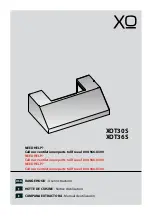
Gas conversions (from Natural gas to L.P. gas; or
from L.P. gas to Natural gas) must be done by a
qualified installer.
L.P. gas conversion
1.
Complete installation sections A-C (Pages
4-5) before converting cooktop to L.P. gas.
Check
that main gas supply line has been shut off and
the power supply cord is disconnected.
4.
Oven burner:
Use 1/2" combination
wrench to turn the orifice hood down snug onto
pin (approximately 2 to 2-1/2 turns).
DO NOT
OVERTIGHTEN.
The burner flame cannot be
properly adjusted if this conversion is not made.
DO NOT REMOVE THE PRESSURE REGULATOR.
2.
Open broiler drawer to locate pressure
regulator.
Pressure regulator:
Remove plastic cover. Turn
cap marked “N” on front of pressure regulator
counterclockwise with a wrench to remove.
Do
Not disturb or remove the spring beneath the
cap.
Turn the cap over and reinstall cap on
regulator so that the letters “L.P.” are visible.
Replace plastic cover over cap.
Page 7
hood
orifice hood
pin
L.P. gas
decrease gas
decrease
flame size
Natural gas
increase gas
increase flame
size pre-set at factory
for Natural gas
Fire Hazard
Shut off gas supply line valve.
Make all conversions before turning gas
supply valve back on.
Failure to follow these instructions can result
in explosion, fire or other injury.
WARNING
6.
Making sure the anti-tip bracket is
installed:
• Look for the anti-tip bracket securely
attached to floor.
• Slide range back so rear range foot is under
anti-tip bracket.
anti-tip
bracket
range foot
A brass orifice spud is located in the center of
each burner throat about 2" below the cooktop.
Apply masking tape to the end of a 5/16" nut
driver to fit snugly over the orifice spud. Press
driver down onto the spud of the left front burner
and remove by turning spud counter-clockwise
and lifting it out. Replace the Natural gas spud
with the appropriate L.P. gas spud shown in the
table.
Continue to replace the remaining orifice spuds,
one at a time. Place the Natural gas spuds in
plastic parts bag for future use and keep with
literature package. Replace burners caps using
both screws, and burner grates.
Surface
Propane
Orifice
Color
burner
Rate (BTU/hr) Number Marking
Left rear
8,000
L80
Green/Lt.Blue
Left front
8,000
L80
Green/Lt.Blue
Right front
8,000
L80
Green/Lt.Blue
Right rear
5,000
L65
Green/Brown
L.P. Gas
5.
Complete installation sections D through
E, Pages 5-7.
Checking for proper cooktop burner
and oven flame is very important.
The small inner cone should have a very distinct
blue flame 1/4" to 1/2" long. The outer cone is not
as distinct as the inner cone. L.P. gas flames may
have a slightly yellow tip.
Nat. gas
L.P.
plastic
cover
pressure
regulator
pressure
regulator
Natural
orifice
number
L.P. gas
plastic
cover
cap
washer
5/16"
nut driver
orifice spud.
Replace orifice
spud with the
number listed
in the chart.
burner
assembly
Locate the L.P. gas orifice spuds in
literature package. Orifice spuds are
stamped with a number and
marked with two color dots
and a groove.
L.P. gas
orifice spud
groove
3.
Surface
Burners:
Remove burner
caps. Use a
Phillips or
Quadrex
screwdriver to
remove the two
screws holding
the burner head down. Lift the
burner head off the cooktop to uncover the
orifice spud holder. The orifice spud is recessed
in the holder.
Note: Reinstall one of the screws through the
range cooktop to hold orifice spud holder in place
while removing and replacing orifice spuds.
reinstall
one of the
screws
orifice
spud
orifice
spud
holder
spark electrode
range cooktop



























